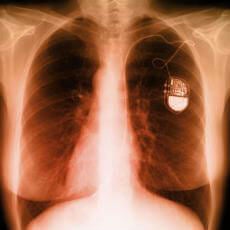
A prototype device that harvests energy from heartbeats shows promise to replace batteries in medical device implants, such as pacemakers, according to the BBC. In preliminary testing, the natural beating of the heart produces enough motion to generate 10 times the amount of energy needed by a pacemaker to function.
The research was led by Professor Dan Inman, chair of the Aerospace Engineering Department at the University of Michigan, as a spin-off of work sponsored by the U.S. Air Force to power wireless sensors in the wings of unmanned aircraft. Research fellow and lead author of the study Dr. M. Amin Karami presented the work at this year’s American Heart Association’s Scientific Sessions.
The medical application of the research may very well be a gold mine for powering implantable devices.
Professor Inman stated that “Pacemaker-dependent people have to have an operation every seven years. If the initial patient is two years old, that’s perhaps 10 times during their lifetime they’ll have to have open-heart surgery, which is expensive, not to mention painful.” He added, “Potentially, one would only need one pacemaker operation — insertion of the initial pacemaker.”
Using piezoelectric components and magnets, the device converts vibrational energy (the energy of motion) into electrical energy. So with each heartbeat, energy that would otherwise be lost primarily as heat would be used to power the pacemaker. The harvester uses the magnets to enhance the power production in order to compensate for changes in the heart rate, so that it runs continuously at 20 beats per minute or even 600, according to Karami.
Inman said, “Batteries are pretty nasty devices to stick inside the human body, and the harvesting materials are a little bit more benign, so it’s also safer.” Additionally, the device is half the size of batteries currently used.
Fine-tuning the device will be accomplished by animal studies and measuring the vibrational energy of a human heart during scheduled open-heart surgeries. The device would then be incorporated into commercial pacemakers and go through testing for safety and reliability, followed by clinical trials to demonstrate that it works as intended for people in their daily lives.
In other words, it may be some years before the technology actually makes it into the marketplace, but the research is a breakthrough for future medicine.
In the following video, Professor Inman explains research in this areas and how they hope to power devices inside the body:
In the past, Singularity Hub has covered stories about body augmentations that fall under an umbrella we like to call Body 2.0. Though most people don’t necessarily like the idea of sticking things inside of them, medical advances have made it increasingly common to have implants, whether they are for anatomical purpose like knee implants or physiological ones, such as pacemakers. Other implantable devices are being considered as well, including sensors that could take continuous measurements at various points throughout the body.
But one big question is how will smart implants be powered?
The research being done with piezoelectronics promises that the natural motion of the body can be utilized for power. While cardiac devices like pacemakers or defibrillators will be initially targeted, devices implanted throughout the body could still draw power from the heart. Another possibility is that alternative forms of motion are used, such as the contraction of smooth muscle in the digestive system or even swinging arms during walking.
A future in which exercise is encouraged as a way of both staying healthy and powering implanted devices could be a win-win scenario for this kind of technology.
The bottom line is that though this research is in it’s infancy for medical applications, it is definitely worth keeping an eye on. The technology that could emerge might be the very thing to help body augmentation, implantable sensors, and even cybernetics to get over the barrier of adoption, helping everyone to be healthier and increase longevity.



